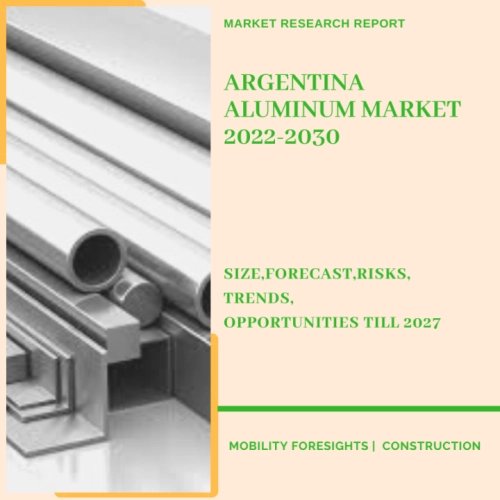
- Get in Touch with Us

Last Updated: Apr 25, 2025 | Study Period: 2022-2030
The third most frequent element and the most plentiful metal in the world, aluminum makes up 8% of the earth's crust. After steel, aluminum is the most often used metal due to its versatility.

Aluminum is made from the mineral bauxite. The Bayer Process is used to transform bauxite into aluminum oxide (alumina).
The Hall-Heroult Process and electrolytic cells are then used to convert the alumina to aluminum metal.
The scale of Argentina's one-of-a-kind primary aluminum producer, with a high overall production capacity, is the market's most distinctive feature.
It is hypothesized that ongoing investment in cutting-edge technology has made it possible to operate despite the crisis at close to full capacity and even exceed global quality requirements.
The Argentina aluminum market accounted for $XX Billion in 2021 and is anticipated to reach $XX Billion by 2030, registering a CAGR of XX% from 2022 to 2030.
Argentina's Hydro aluminum factory is the first in the nation to receive ASI certification.
To see sustainability and human rights principles become more deeply ingrained in supply chains, Hydro, a Norwegian aluminum and renewable energy company dedicated to a sustainable future,
has announced that its aluminum extrusion plant in Pilar, Argentina has become the first in the nation to receive certification in accordance with the ASI Performance Standard.
The ASI Performance Standard, which is used by Hydro Extrusion Argentina, acknowledges the ethical manufacturing, sourcing, and stewardship of aluminum.
Hydro Extrusion Argentina operates one of the most technologically sophisticated extrusion. The facility is proactive in product creation under a sustainable manufacturing approach and serves clients in several industries, including the building and construction industry.
Argentina opens an AD investigation into aluminum foil. Argentina's Ministry of Production and Labor, that it would open an anti-dumping inquiry into aluminum foil coming from China.
The products in question must be laminated aluminum foil with a thickness greater than or equal to 0.006 millimeters, less than or equal to 0.2 millimeters, and a width less than or equal to 1300 millimeters,
apart from glossy aluminum foil with an aluminum content greater than 99.2% by weight, a thickness of six millimeters, and a width of five hundred millimeters or less.
| Sl no | Topic |
| 1 | Market Segmentation |
| 2 | Scope of the report |
| 3 | Abbreviations |
| 4 | Research Methodology |
| 5 | Executive Summary |
| 6 | Introduction |
| 7 | Insights from Industry stakeholders |
| 8 | Cost breakdown of Product by sub-components and average profit margin |
| 9 | Disruptive innovation in the Industry |
| 10 | Technology trends in the Industry |
| 11 | Consumer trends in the industry |
| 12 | Recent Production Milestones |
| 13 | Component Manufacturing in US, EU and China |
| 14 | COVID-19 impact on overall market |
| 15 | COVID-19 impact on Production of components |
| 16 | COVID-19 impact on Point of sale |
| 17 | Market Segmentation, Dynamics and Forecast by Geography, 2022-2030 |
| 18 | Market Segmentation, Dynamics and Forecast by Product Type, 2022-2030 |
| 19 | Market Segmentation, Dynamics and Forecast by Application, 2022-2030 |
| 20 | Market Segmentation, Dynamics and Forecast by End use, 2022-2030 |
| 21 | Product installation rate by OEM, 2022 |
| 22 | Incline/Decline in Average B-2-B selling price in past 5 years |
| 23 | Competition from substitute products |
| 24 | Gross margin and average profitability of suppliers |
| 25 | New product development in past 12 months |
| 26 | M&A in past 12 months |
| 27 | Growth strategy of leading players |
| 28 | Market share of vendors, 2022 |
| 29 | Company Profiles |
| 30 | Unmet needs and opportunity for new suppliers |
| 31 | Conclusion |
| 32 | Appendix |